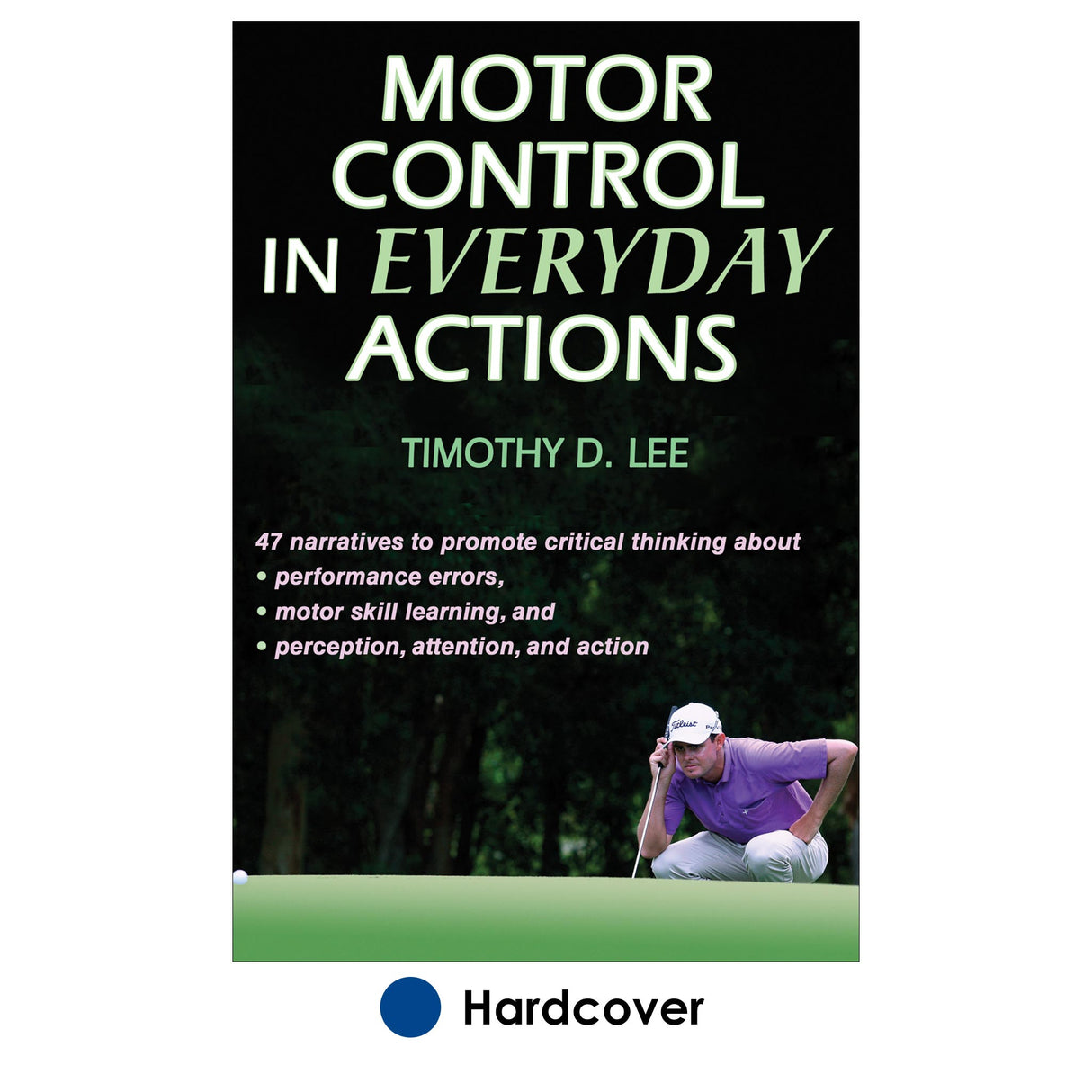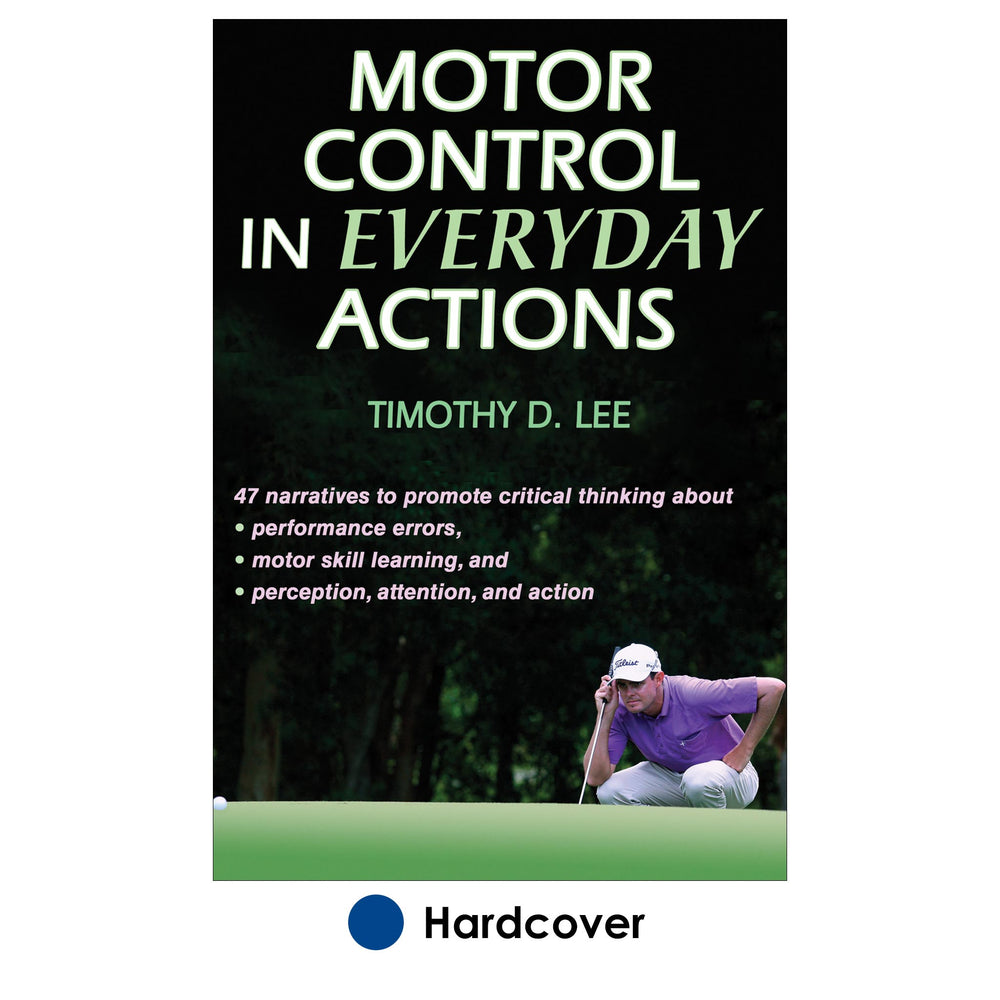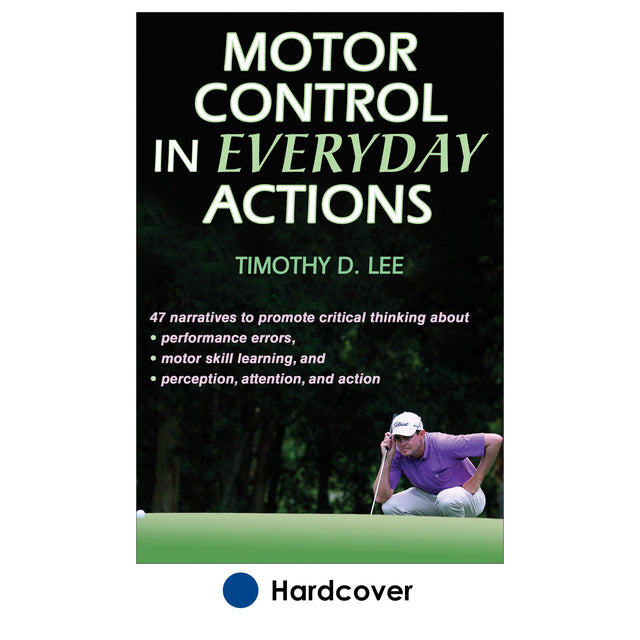Motor Control in Everyday Actions
Author: Tim Lee
$56.00 USD
Motor Control in Everyday Actions presents 47 true stories that illustrate the phenomena of motor control, learning, perception, and attention in sport, physical activity, home, and work environments. At times humorous and sometimes sobering, this unique text provides an accessible application-to-research approach to spark critical thinking, class discussion, and new ideas for research. The stories in Motor Control in Everyday Actions illustrate the diversity and complexity of research in perception and action and motor skill acquisition. More than interesting anecdotes, these stories offer concrete examples of how motor behavior, motor control, and perception and action errors affect the lives of both well-known and ordinary individuals in various situations and environments.
Readers will be entertained with real-life stories that illustrate how research in motor control is applicable to real life:
•Choking Under Pressure examines information processing and how it changes under pressure.
•The Gimme Putt shows how Schmidt’s law can be used to predict the accuracy of golf putts.
•Turn Right at the Next Gorilla examines inattention blindness and its role in traffic accidents.
•The Farmers’ Market describes reasons why a man drives his car through a crowded open-air market, killing and injuring dozens of shoppers in the process.
•Craps and Weighted Bats describes the curious role of myths and superstition in how we play games.
•And 42 other examples of motor control in everyday actions will both entertain and inform.
Each story is followed by a set of self-directed activities that are progressively more complex. These activities, plus the additional notes and suggested readings and websites at the conclusion of each story, provide a starting point for critical thinking about the reasons why human actions sometimes go awry. A reader-friendly writing style and easy-to-follow analysis and conclusions assist students in gaining mastery of the issues presented, conceptualizing new research projects, and applying the content to current research.
The stories are grouped into three parts, beginning with situations involving errors and mistakes in perception, action, or decision making. Next, stories investigating varied techniques for studying perception and action are presented. The remaining scenarios provide readers with a look at research focusing on the motor learning process as well as some of the unexpected discoveries resulting from those investigations.
Motor Control in Everyday Actions will engage its readers—not only through the central topic of the story but also in the fundamental concepts involving perception, action, and learning. Used as a springboard for new research or as a catalyst for engaging discussion, Motor Control in Everyday Actions offers perspectives that will enhance understanding of how human beings interact with their world.
Audience
A supplemental text for undergraduate and graduate motor behavior, motor learning, and motor control courses. Also a reference for academic libraries and researchers.
Part I. Stories About Perception and Action Gone Wrong
Chapter 1. Perceptual Errors
The Magnetic Hill
How do visual illusions distort perception and influence action?
The Farmers' Market
What are the roles of motor error and hypervigilance in unintended acceleration accidents?
The Grocery Store
How do population stereotypes shape our interactions with manufactured environments?
Push or Pull?
How do product designs influence people to perform specific actions?
Chapter 2. Decision Errors
Friendly Fire
What role did decision errors play in the death of Patrick Tillman?
Method to His Bratness
Did John McEnroe's verbal abuse of line judges influence their decisions?
Choking Under Pressure
What changes in information processing cause athletes such as Jean Van de Velde to fail under pressure?
Turn Right at the Next Gorilla
What is inattention blindness, and what role does it play in common traffic accidents?
Chapter 3. Action Errors
The Calculator
How can product designs accommodate Fitts' law?
The Gimme Putt
Can Schmidt's law be used to predict the accuracy of golf putts?
Pouring Coffee
How does the information-processing rate create a speed–accuracy trade-off?
Is the Bean Dizzy?
What do Spoonerisms reveal about motor control?
Part II. Adventures in Perception and Action
Chapter 4. Fun With Numbers
Public Opinion Polls
What do central tendency, variability, and statistical significance mean in the context of motor research?
Cutting Wood and Missing Putts
How are constant error, variable error, and absolute error useful for understanding motor control?
The Hot Hand
Do statistics support the existence of hot streaks in sports?
Chapter 5. Perception in Action
Red Light, Green Light
What factors influence reaction time and its measurement?
Jumping the Gun
How can a reaction be distinguished from an anticipation?
Antilock Brakes
How does the complexity of a motor program influence reaction time?
Preventing Penalties and Batting Baseballs
How do athletes use temporal and spatial anticipation?
Craps and Weighted Bats
What role do perceptual illusions play in sport performance?
Chapter 6. Attention
The Toad and the Centipede
Is an internal or external attentional focus better for improving performance?
The Preshot Routine
Why does a consistent mental preparation ritual benefit performance?
Gumbo
What are the limits of attentional capacity?
Fakes
What role does the psychological refractory period play in sport?
Chapter 7. Motor Control
Websites and Silly Walks
How do redundancies help us solve motor problems?
The Curling Draw
What sport skills use open- and closed-loop systems of motor control?
Cool Papa Bell
When vision is interrupted, how does iconic memory guide motor tasks?
Moving Sidewalks and Beer Glasses
How does the end-state comfort effect influence movement planning?
The Tickle
How do motor commands influence sensory feedback during motor control?
The Point of No Return
Is there a point in time after which an initiated motor program cannot be stopped?
Forensic Motor Control
What are generalized motor programs and what do keystroke dynamics reveal about them?
Party Tricks
How does our nervous system use functional linkages to coordinate movements?
Disappearing Act
What makes some coordination patterns more automatic than others?
Part III. Stories About Learning Motor Skills
Chapter 8. Measuring Motor Learning
How You Get to Carnegie Hall
What is the best way to measure progress in motor learning?
The Babe
Can a general motor ability be defined and measured?
Learning to Win From Losing
Why is the learning-performance distinction important?
Zero-Sum Training
What is the practical impact of ineffective training methods?
Chapter 9. Organizing Practice
But I Was Great on the Practice Range!
How does practice repetition influence performance and learning?
The Coach as a Dictionary
What roles does augmented feedback play in motor learning?
The Golfer’s Little Helper
What elements of motor learning are neglected when we use mechanical training aids?
Chapter 10. Skill Development
Bend It Like Becker
What types of models are best to observe when learning a skill?
Sport Snake Oils
Can visual training programs improve sport performance?
The Keypad
How do explicit and implicit memories influence skilled performance?
Wayne Gretzky
What role does skilled perception play in sport performance?
Chapter 11. Skill Retention
Shooting Two From the Line
How does the warm-up decrement affect repeated performances?
Like Riding a Bicycle
How are motor skills stored in memory?
H.M.
What does the amnesia suffered by Henry Gustav Molaison reveal about memory and motor skills?





